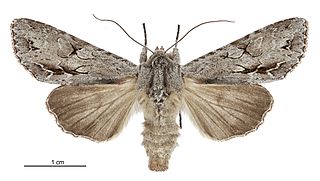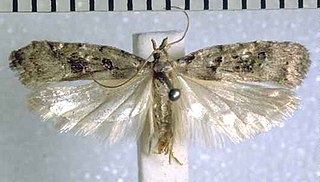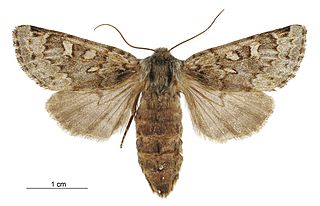Related Research Articles

The tawny speckled pug is a moth of the family Geometridae.

Phymatopus is a genus of moths of the family Hepialidae, which consists of around 500 species and 30 genera. The genus was erected by Hans Daniel Johan Wallengren in 1869. They can be found across Eurasia and North America. Species can be distinguished by the different morphology of male genitalia and different forewing patterns, which vary in stripe colour and size and arrangement of spots. The stripes themselves consist of spots separated by dark veins which are fringed by thin black lines from both inner and outer sides.

Smerinthus ocellatus, the eyed hawk-moth, is a European moth of the family Sphingidae. The species was first described by Carl Linnaeus in his 1758 10th edition of Systema Naturae.

Tyta luctuosa is a noctuid ("owlet") moth. Its common names include four-spotted moth and field bindweed moth. It is the only member of the genus Tyta, which belongs to the Metoponiinae subfamily. The species was first described by Michael Denis and Ignaz Schiffermüller in 1775. The genus was erected by Gustaf Johan Billberg in 1820.

Nepita is a monotypic moth genus in the subfamily Arctiinae erected by Frederic Moore in 1860. Its only species, Nepita conferta, the footman moth, was first described by Francis Walker in 1854. It is found in India and Sri Lanka.

Cosmorhoe is a monotypic moth genus in the family Geometridae erected by Jacob Hübner in 1825. Its only species, Cosmorhoe ocellata, the purple bar, was described by Carl Linnaeus in his 1758 10th edition of Systema Naturae.

Ichneutica lignana is a moth of the family Noctuidae. It is endemic to New Zealand. This species is found on the Three Kings Islands as well as the North, South and Stewart Islands. This species lives in a variety of habitats including coastal areas, tussock grasslands, shrublands, and native forest, at a range of altitudes from sea level to over 1300 m. I. lignana is quite distinctive in appearance with its dark markings on the abdomen and forewings although it is possible to confuse Ichneutica morosa, Meterana pansicolor and Meterana pascoi with this species. Adults are on the wing throughout the year in the northern parts of the New Zealand but are restricted to the months of October to April in the more southern parts of the country.

Ichneutica ustistriga is a moth of the family Noctuidae. It is endemic to New Zealand and can be found from the Three Kings Islands to Stewart Island. This species lives in a wide variety of habitats including domestic gardens, horticultural areas, orchards, native and exotic grasslands, as well as native forest. The larvae eat a variety of herbaceous plants. Recorded food plants include Muehlenbeckia australis, Muehlenbeckia complexa, Olearia hectorii, Plantago lanceolata, and Urtica australis. This moth has a mauvish grey wing colour and is unlikely to be confused with other species as the patterns on its forewing are distinctive. This species is on the wing throughout the year and is attracted to both sugar and light traps. Adult moths can be found at rest on fences and tree trunks during the day.

Grotella septempunctata is a moth in the genus Grotella, of the family Noctuidae. The species was first described by Leon F. Harvey in 1875. It can be found in North America, from Texas to Colorado.

Heterocrossa canescens is a species of moth in the family Carposinidae. It is endemic to New Zealand. This species has been observed in Aoraki / Mount Cook National Park and in the Southern Alps. The larvae of this species feed on the fruits and flowers of endemic to New Zealand species in the genus Gaultheria. Adult moths are on the wing in November and from January to March.

Cahela is a monotypic snout moth genus described by Carl Heinrich in 1939. Its only species, Cahela ponderosella, the cahela moth, described by William Barnes and James Halliday McDunnough in 1918, is found in Mexico and in the US states of California, Texas, Arizona, Utah and probably Nevada.
Epeiromulona hamata is a moth of the subfamily Arctiinae. It was described by William D. Field in 1952. It is found in Trinidad, northern South America and Brazil.
Epeiromulona icterinus is a moth of the subfamily Arctiinae. It was described by William D. Field in 1952. It is found in Guatemala and Panama.
Epeiromulona lephina is a moth of the subfamily Arctiinae. It was described by William D. Field in 1952. It is found in Panama and Guatemala.
Epeiromulona roseata is a moth of the subfamily Arctiinae, described by William D. Field in 1952. It is found in Mexico, Honduras, and Costa Rica.

Epeiromulona thysanata is a moth of the subfamily Arctiinae. It was described by William D. Field in 1952. It is found in French Guiana, Guyana, Suriname, Costa Rica and Panama.

Ichneutica nullifera is a moth of the family Noctuidae. This species is endemic to New Zealand and can be found in the Tongariro National Park, along the Wellington coast and throughout the South Island. The adults are large and the forewing of adults can vary in colour from pale fawn to dark grey. The larvae are coloured a bright yellow-brown with a paler underside. The larval host species are in the genus Aciphylla and as a result the adult moths are often found in habitat dominated by species in this genus. Adults are on the wing from November to early April and are sometimes attracted to light.

Ichneutica blenheimensis is a species of moth in the family Noctuidae. It is endemic to New Zealand and is found throughout the North, South and the Stewart Islands. This species appears to prefer drier eastern localities and is rarely collected in western North Island forested areas. It does not appear to be frequently collected in inland dry tussock grassland habitats. The host plant for the larvae of this species is likely to be the golden sand sedge pīngao which is now absent from the moths type locality. However Chappell has raised very young larvae on grass species and the more developed larvae consumed Phormium tenax. Adults are on the wing from November to March and are attracted to both light and sugar traps. The blackish forewing fringes are diagnostic of this species. But worn specimens of I. arotis can be confused with worn specimens of I. blenheimensis. However I. arotis can be distinguished from I. blenheimensis as it has a scale-tuft on the thorax and dark longitudinal stripes on the tegula. This species is classified as "At Risk, Naturally Uncommon" by the Department of Conservation.

Ichneutica notata is a moth of the family Noctuidae. It is endemic to New Zealand. Although similar in appearance to other species in the Ichneutica genus, it can be distinguished by the colouration and patterns on its wings. It appears to be a very local species, rarely collected and having only been recorded in the north-west of the Tasman District, the Paproa Range, the Rainbow Ski field and the Craigieburn Range. Very little is known of the life history of I. notata.

Ichneutica sistens is a moth of the family Noctuidae. This species is endemic to New Zealand. It can be found in the central North Island and throughout the South Island, although it is more common on the eastern side of that latter Island. It is very variable in both colour and size. I. sistens prefers open habitat such as tussock grasslands, dunes and braided rivers. Larval host species include grasses in the family Poaceae and include species in the genera Rytidosperma and Elymus, as well as Poa cita and Agrostis capillaris. Adults are on the wing from January to May and are attracted to light.
References
- ↑ Field, William D. (1952). "Moths of the Genus Epeiromulona, a New Genus of Lepidoptera" (PDF). Proceedings of the United States National Museum. 102 (3308): 455–469. doi:10.5479/si.00963801.102-3308.455.
 This article incorporates text from this source, which is in the public domain .
This article incorporates text from this source, which is in the public domain .
- Pitkin, Brian & Jenkins, Paul. "Search results Family: Arctiidae". Butterflies and Moths of the World. Natural History Museum, London.